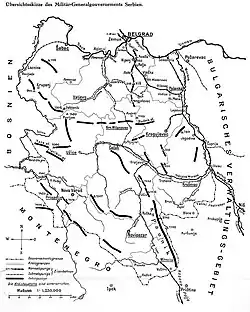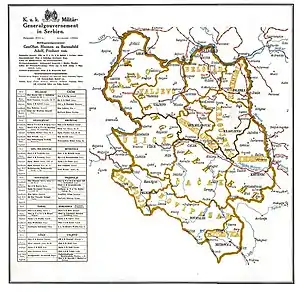Military General Governorate of Serbia
The Military General Governorate of Serbia (German: Militärgeneralgouvernement Serbien, MGG/S for short) was a military administration established by the Austro-Hungarian Army during the Austro-Hungarian occupation of Serbia. The Governorate existed from 1 January 1916 to 1 November 1918 during World War I. Along with Bulgarian occupied Serbia, it was one of the two separate occupation zones created after the Kingdom of Serbia was invaded and partitioned by the Central Powers.
Imperial and Royal Military General Governorate of Serbia | |||||||||
|---|---|---|---|---|---|---|---|---|---|
| 1916–1918 | |||||||||
 Flag | |||||||||
 Map of the Military Governorate of Serbia | |||||||||
| Status | Territory under Austro-Hungarian Military administration | ||||||||
| Capital | Belgrade | ||||||||
| Official languages | German | ||||||||
| Recognized national languages | Serbian | ||||||||
| Government | Occupation authority | ||||||||
| Military Governor | |||||||||
• 1916 | Johan von Salis-Seewis | ||||||||
• 1916−1918 | Adolf von Rhemen | ||||||||
• 1918 | Hermann Kövess | ||||||||
| Historical era | First World War | ||||||||
• Established | 1 January 1916 | ||||||||
| 11 November 1918 | |||||||||
| Area | |||||||||
• Total | 23,880 km2 (9,220 sq mi) | ||||||||
| Population | |||||||||
• 1916 estimate | 1 373 511 | ||||||||
| Currency | Serbian dinar[lower-alpha 1] | ||||||||
| ISO 3166 code | RS | ||||||||
| |||||||||
| Today part of | Serbia | ||||||||
History
During the unsuccessful Austro-Hungarian Serbian campaign of 1914, a first military governorate was set up in Belgrade by the Austrian Supreme Command. Field-Marshal Stjepan Sarkotić, commander of the Devils's Division, was appointed military governor in November.[1] The Serbian army’s counteroffensive a month later liberated the country, ending the short-lived occupation. Following the Central Powers' Serbian campaign of 1915 and the subsequent retreat of the Serbian army, the country was divided into three zones of control, Austria-Hungarian, German and Bulgarian.[2]
The Austro-Hungarian zone encompassed the northwestern part of Serbia, with Belgrade as its administrative centre, to the north-east corner near Negotin. The areas east of the Morava, Macedonia itself and most of Kosovo fell under Bulgarian occupation. The Germans decided not to seek territory for themselves but took control instead of railways, mines, forestry, and agricultural resources in both occupied zones; in the area east of Velika Morava, Južna Morava in Kosovo and the Vardar valley.[3] The Austro-Hungarian occupiers established a similar military administration in the territory of the Kingdom of Montenegro.[4]
The Austro-Hungarian Military Governorate in Serbia was officially started on 1 January 1916 by order of the Austro-Hungarian Supreme Command.[5]
Governance
The MGG/S was directly subordinated to the Austro-Hungarian Army High Command under Franz Conrad von Hötzendorf and later Arthur Arz von Straußenburg.[6]
General Johann Graf von Salis-Seewis, a Croat by ethnicity, was appointed Military Governor-General by the Emperor at the end of 1915, he assumed his position on 6 January 1916.[7] The governor-general was supported by Chief of Staff, Lieutenant Colonel Otto Gellinek, who been military attaché in Belgrade before the war.[8]
General von Salis-Seewis was replaced by General Adolf Freiherr von Rhemen on 6 July 1916, while Colonel Hugo Kerchnawe succeeded Lieutenant Colonel Otto Gellinek.[9]
A civilian commissioner was appointed by the Hungarian government, to assist the military governor-general. Dr. Ludwig (Lajos) Thallóczy, a Hungarian historian and Balkan expert, took office on 17 January 1916.[6] After his accidental death in December 1916, he was succeeded by Teodor Kušević in January 1917.[6]
| Military Governors | Term |
|---|---|
| Feldmarschallleutnant Johann Ulrich Graf von Salis-Seewis | 1 January 1916 – 6 July 1916[6] |
| Generaloberst Adolf Freiherr von Rhemen zu Barensfeld | 6 July 1916 – October 1918[9] |
| Feldmarschall Hermann Kövess von Kövessháza | October 1918 – 1 November 1918[10] |
| Civilian Commissioners | Term |
| Ludwig Thallóczy | 17 January 1916 – 1 December 1916[6] |
| Teodor Kušević | January 1917 – 1 November 1918[6] |
Four administrative departments were set up: military, economic, judicial, and political, with the latter under future Ustaše leader Slavko Kvaternik.[11]
Administrative divisions
The administrative divisions initially consisted of five county commands or provinces, based on pre-war Serbia’s counties, as established during the brief occupation of 1914. After March 1916 the divisions came up to a total of twelve provinces plus the city of Belgrade:[5] Each of the twelve provinces (German: Kreise), were ruled by a commander (German: Kreiskonimandanten) who was responsible for all military and civil affairs. The provinces were additionally divided into sixty-four districts (German: Bezirkskommandos).[12] Civil administration in towns and villages was done by a Predsednik, a community leader chosen from the ranks of the local population.[13]

| Province | Population (based on MGG/S 1916 census) | Notes |
|---|---|---|
| Belgrade city | 9,000[lower-alpha 2] | from 1 January 1916 |
| Belgrade province | 179,173 | |
| Valjevo province | 117,502 | |
| Šabac province | 161,569 | |
| Gornji Milanovac province | 70,029 | |
| Kragujevac province | 155,461 | |
| Smederevo province | 117,254 | |
| Kruševac province | 195,655 | From 11 February 1916[5] |
| Čačak province | 114,783 | Established on 1 January 1916 and incorporated into the MGG/S in February the same year, with the following districts: Čačak, Kraljevo, Ivanjica, Guča, Ušće and (from August 1917) Raška.[15] |
| Užice province | 114,061 | |
| Prijepolje province | 37,826 | From 15 March 1916[16] |
| Novi-pazar province | 71,746 | |
| Kosovska Mitrovica province | 45,912 | |
After the Austro–Bulgarian confrontation of April 1916, the cities of Prizren and Pristina in Kosovo were subordinated to the Austro-Hungarian governorate.[16]
Dissolution
In mid October 1918, overwhelmed by the Allies offensive spearheaded by Serbian and French troops, Governor Hermann von Kövess ordered a retreat of all the remaining Austro-Hungarian personal behind the Danube, Save and Drina rivers; Belgrade was liberated on 30 October, thus ending the Military General Governorate of Serbia.[17]
See also
Notes
- Handstamped with K.u.K. Militär-Generalgouvernement in Serbien
- from pre war population of 82 498[14]
References
- Wawro 2014, p. 195.
- Luthar 2016, p. 75.
- Mitrović 2007, p. 183.
- Mitrović 2007, p. 204.
- Mitrović 2007, p. 201.
- Mitrović 2007, p. 203.
- Buttar 2016, p. 43.
- Herwig 2014, p. 13.
- Schweizerische Offiziersgesellschaft 1968, p. 386.
- Rauchensteiner, Kay & Güttel-Bellert 2014, p. 987.
- Jarman 1997, p. 261.
- Gumz 2014.
- Jungerth 1918, p. 35.
- Goebel & Keene 2011, p. 102.
- Knjizara.com.
- Mitrović 2007, p. 202.
- Herwig 2014, p. 421.
Sources
- Buttar, P. (2016). Russia's Last Gasp: The Eastern Front 1916–17. Bloomsbury Publishing. ISBN 978-1-4728-1277-3.
- Dawnay, G.P.; Headlam, C.M. (1933). The Army Quarterly. William Clowes & Sons, Limited.
- DiNardo, R.L. (2015). Invasion: The Conquest of Serbia, 1915. War, technology, and history. ABC-CLIO, LLC. ISBN 978-1-4408-0092-4.
- Goebel, S.; Keene, D. (2011). Cities Into Battlefields: Metropolitan Scenarios, Experiences and Commemorations of Total War. Historical urban studies. Ashgate. ISBN 978-0-7546-6038-5.
- Gumz, J.E. (2014). The Resurrection and Collapse of Empire in Habsburg Serbia, 1914-1918: Volume 1. Cambridge University Press. ISBN 978-1-107-68972-5.
- Herwig, H.H. (2014). The First World War: Germany and Austria-Hungary 1914-1918. Modern Wars. Bloomsbury Publishing. ISBN 978-1-4725-1081-5.
- Jarman, R.L. (1997). Yugoslavia: 1938-1948. Yugoslavia: Political Diaries, 1918–1965. Archive Editions Limited. ISBN 978-1-85207-950-5.
- Jungerth, M. (1918). k. u. k. Military administration in Serbia in 1916 and 1917 issued ordinances (in German). k. u. k. Gouvernement-Dr.
- Luthar, O. (2016). The Great War and Memory in Central and South-Eastern Europe. Balkan Studies Library. Brill. ISBN 978-90-04-31623-2.
- Mitrović, A. (2007). Serbia's Great War, 1914-1918. Central European studies. Purdue University Press. ISBN 978-1-55753-476-7.
- Rauchensteiner, M.; Kay, A.J.; Güttel-Bellert, A. (2014). The First World War and the End of the Habsburg Monarchy, 1914-1918. V&r Academic. ISBN 978-3-205-79588-9.
- Schweizerische Offiziersgesellschaft (1968). Allgemeine schweizerische militärzeitschrift (in German). Huber.
- Tucker, S.; Roberts, P.M. (2005). World War I: Encyclopedia. World War I: Encyclopedia. ABC-CLIO. ISBN 978-1-85109-420-2.
- "Život pod okupacijom (čačanski okrug 1915-1918) : Bogdan Trifunović". Knjizara.com (in Serbian).
- Wawro, G. (2014). A Mad Catastrophe: The Outbreak of World War I and the Collapse of the Habsburg Empire. Basic Books. ISBN 978-0-465-08081-6.